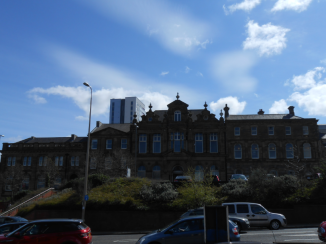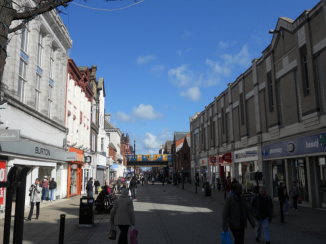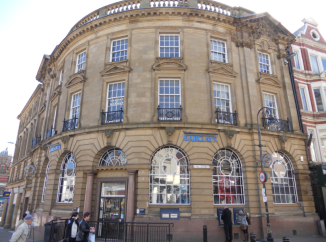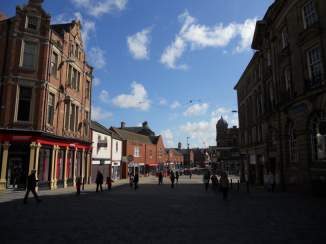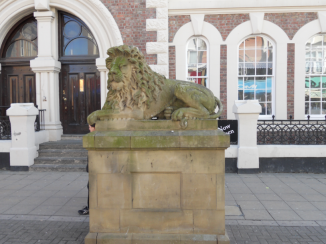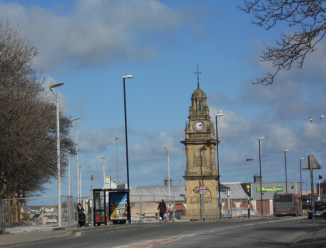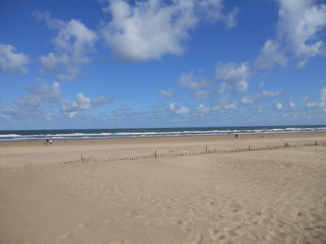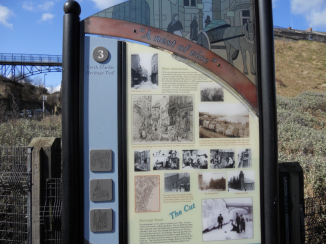After spending an extraordinary morning in the city of Durham, we moved back past the Angel of the North, and through to Newcastle and Gateshead. We have been to Newcastle a few times since this trip so I have reorganised this post to add in some finds from our other trips and show you what the city has to offer.
Newcastle-upon-Tyne:
Status: City of Newcastle District, Tyne & Wear, City, England
Date: Various
Travel: East Coast (Newcastle – Berwick-upon-Tweed), Scotrail (Carlisle – Newcastle), Northern Rail (Newcastle – Middlesbrough)
Eating & Sleeping: N/A
Attractions: Newcastle Cathedral, Newcastle Castle, River Tyne, Tyne Bridge, Redheugh Bridge, Tyne & Wear Metro, Grey’s Monument, Discovery Museum, Grey’s Monument, Gateshead Millennium Bridge, High Level Bridge, Queen Elizabeth II Metro Bridge, King Edward VII Bridge, Swing Bridge etc
The River Tyne flows between the City of Newcastle, and the town of Gateshead. It begins life as two separate rivers, the North Tyne and the South Tyne which meet near Hexham in Northumberland and then run through here and out into the North Sea at North & South Shields. The County of Tyne & Wear was created in 1974 and named after the Tyne, along with the River Wear that runs through the cities of Durham and Sunderland (Sunderland was also included in the county). Historically Newcastle was in Northumberland and Gateshead was in County Durham and the river marked the boundary between the two counties.
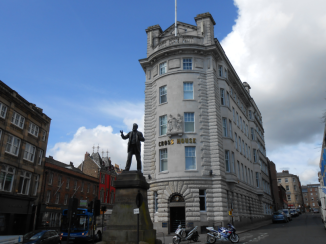
We left Newcastle Central station, which is in the heart of the city. There are a number of fantastic looking buildings around the city, including the above one, named Cross House. It opened in 1911, as an office block with 7 floors. It was also the scene of a deadly fire in 1919 when a large amount of celluloid film in the basement caught fire, killing 11 people, however it led to new laws to control how this volatile substance is stored and it no doubt saved many other lives for the future.
The statue in front of the building is of Joseph Cowen (1829 – 1900, MP for Newcastle in 1874) is one of a large number of statues and sculptures throughout Newcastle.
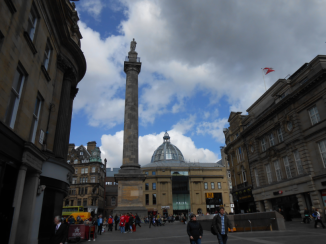
Moving further into the city centre, we went up Grainger Street to the pedestrianised sections approaching Grey’s Monument, the large column shown above. The column was erected in 1838, as a permanent memorial to Charles Grey, 2nd Earl Grey (1764 – 1845, UK Prime Minister between 1830 and 1834). A statue of Mr Grey stands on the very top of the column, and the situation is very reminiscent of Nelson’s Column in Trafalgar Square, London. It’s a very impressive sight as you approach it, and standing beneath it you gaze up at the very top, towering above you.
Behind the column is the entrance to Monument Mall, which opened in 1990. Monument Metro Station is also located in the square, with an entrance at either side. You can see one of the two on the right.
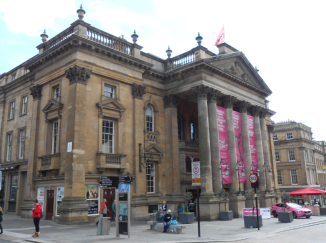
Also in this area, just down one of the streets off the square is the Theatre Royal, which opened in 1837. This fantastic building was designed by a group of local architects called John and Benjamin Green, a father and son team. The whole interior was redesigned in 1901, by Frank Matcham (1854 – 1920, English Architect), and because of this the restaurant inside the theatre is named after Matcham.
There are four levels in the main theatre, with enough space overall for 1294 people. It is a very well known local building, and regularly holds various productions, with the very first one back in 1837 being “The Merchant of Venice” by William Shakespeare from 1598.

Going back to Grey’s Monument and then down a road off to the left of the square, you will arrive at another square, which sits in the middle of the enormous Eldon Square Shopping Centre, which opened in 1977. There used to be a large terrace development in the area between 1824 and the 1960’s however most it was demolished to make way for the shopping centre.
The square itself is quite pleasant, with a large War Memorial in the centre, which features St George (Patron Saint of England) vanquishing a dragon, and unveiled in 1923.
The square itself was built between 1825 and 1840 making it part of the original terraced houses, with the shopping centre growing up around it. The designer was John Dobson (1787 – 1865, English Architect) and one side of terraced houses do still inhabit the square, at this side of the square.

Newcastle seems to be full of squares, and there is another on the other side of Eldon Square Shopping Centre. This contains the Church of St Thomas the Martyr, as well as the impressive Civic Centre which houses Newcastle City Council, and acts as the City Hall.
So, looking at the beautiful church that first greeted us, I was struck by the spires all around it, as well as the incredible tower which has a large space partway up between the columns, letting the light shine through. Another monument for St George stands outside the church on the right, with another poor dragon having met it’s fate at his hands.
A chapel was first built in the city in the 1170’s, by Hugh de Morville (Died 1202, Anglo-Norman Knight) who is one of four men convicted of murdering Thomas Becket, Archbishop of Canterbury, in 1170. He set up the chapel in memory of his victim. The chapel was located down by the river, next to the Swing Bridge, and it suffered greatly, being destroyed a number of times. The new church, on it’s present site, opened in 1830, and was also designed by John Dobson. The church doesn’t actually belong to any parishes, however there are regular services. It used to be associated with the Hospital of St Mary Magdalene, although it has long since gone.

Elsewhere in the square, the second main War memorial in the city is surrounded by brightly coloured flowerbeds showcasing a variety of different flowers. The monument itself is a large granite block, with thirty Bronze soldiers at the front, being led by a drummer. They are running off to war, and it commemorates the Northumberland Fusiliers, with children running alongside them waving them off. On the other side of the memorial is a carving of St George, with a pair of Sea Horses, which are part of the cities coat of arms.
Behind the memorial, the distinctive copper ribbed-dome of the Civic Centre rises high above the square. On top of each rib is the head of a Sea Horse which I mentioned just before. It is a great building, running almost the length of the far side of the square. It is quite similar to the one we saw in the Scottish town of Kirkcaldy, and was officially opened in 1968 by King Olav V of Norway (1903 – 1991). It is one of my favourite buildings in the city, there is something about old copper structures that have gone that lovely green colour that really captures my imagination, and there are plenty of them about.

There are a number of other interesting buildings in the vicinity of the square, including the adjacent University of Newcastle, as well as the above building, the Great North Museum: Hancock, which is split into three sections. The first is the Hancock Museum from 1884, the second is the Hatton Gallery from 1925 and then the Newcastle University Regional Resource Centre from the 2000’s. It is a very grand building, and covers a variety of exhibits from dinosaur skeletons to the Egyptians. The current museum was opened by Queen Elizabeth II in 2009, inheriting the collections of the previous museum and bringing everything in the building together.
Outside the museum stands a statue of William George Armstrong, 1st Baron Armstrong (1810 – 1900, industrialist from the city).
We pushed on, and made our way down the quay’s. We have been to Newcastle a few times, and there are 7 different bridges that cross the River Tyne from Newcastle City Centre over into the town of Gateshead. Before today we had only been over 5 of them, so we were determined to get the last 2.
The first bridge we crossed we have been over before in the car, but not on foot (not counting as 1 of the 2 we needed). It is called the Tyne Bridge, and you get some incredible views over the city from here, down to the various streets in and around the quayside, as well as two adjacent bridges.
The smaller of the two is the Swing Bridge, which was built to replace a series of older bridges along the Tyne, with the first Roman Bridge called Pons Aelius dating back to 122. Stone bridges followed in 1270 and 1781 after their predecessors subsequent destructions. The 1781 stone bridge was demolished to allow large ships to use the Tyne, and the Swing Bridge built in it’s place to allow both cars and river traffic. Normally it is in the straight position from one side of the river to other, but to allow river traffic it rotates so it’s vertical to it’s original position and boats can pass past on either side of the central pier. This is the 1st of the 2 we needed to complete our collection of bridges across the Tyne.
The other bridge is called the High Level Bridge, the oldest of the 7 standing bridges, which was built between 1847 and 1849 by Robert Stephenson (1803 – 1859, railway Engineer and son of George Stephenson who built the first inter-city train line to use Steam Engines, between Manchester and Liverpool). Together the six spans of the bridge run 407.8 metres, 12.2 metres wide. When this was built the Stone Bridge still existed, so there was a completely different landscape on the river back in those days. The colour scheme for the High Level Bridge is very similar to the Tyne Bridge, with the stone supports and the Green metal sections.
From here you can also see two other notable landmarks back in the city centre. The first of these is the impressive Cathedral, the lantern spire of which you can see rising above the single arch bridge crossing one the city streets. This is the Cathedral Church of St Nicholas, one of two Cathedrals in the city, with the other being St Mary’s Roman Catholic Cathedral which we will get to later.
It is a relatively low key cathedral compared to some of the others we have been to but the detail and architecture is no less impressive, especially the spire, which is known as a Lantern Spire, from 1448. We have seen similar ones in Belfast, Edinburgh and Aberdeen and its the only example we have seen so far in England. The tower overall is 59.89 metres tall, and the spire has four unique statues, one at each corner. They are of Adam – eating the Apple, Eve – Holding out the Apple, Aaron – Dressed as a Bishop and David – Holding a Harp.
It began life as the parish church in 1091, and it remained relatively stable since then. The Scottish took control the city in 1640 for a brief period, and properly in 1644 for nine weeks. The interior of the Cathedral was badly damaged and the spire and tower were under threat of burning, but the Mayor of Newcastle put the Scottish prisoners inside the tower to deter this. By 1882 the population of Newcastle grew so a new diocese was called for, and St Nicholas Parish Church was elevated Cathedral Status to head the new diocese. We have been inside and it is beautifully decorated and there is much to explore, from the exquisite stained glass windows to the imposing organ on one wall.
The second landmark is the Castle Keep, the tall square building with turrets near the end of the High Level Bridge in the city centre. It should come as no surprise that it was this Castle that gave the overall city it’s name. The Keep stands 81 feet tall and is easily visible from the platforms at Newcastle Central Station.
The first defensive site here was part of the Roman Fort of Pons Aelius which I mentioned earlier which also included the original bridge over the river. In 1080 a new wooden Castle was constructed by Robert Curthose (1054 – 1134, son of William the Conqueror). In 1095 the Earl of Northumbria captured the Castle and became a property of the crown. It was soon replaced by a stone keep between 1172 and 1250 by Henry II (1133 – 1189).
The next major section, the Black Gate, was added in 1250 by Henry III (1207 – 1272). The Black Gate also survives today and is just across the road from the Castle as you explore the city centre. It is so named, as one of the tenants who inhabited it later in it’s life was called Patrick Black. The Gate was leased by James I (1566 – 1625) to a courtier who altered it and rebuilt the top floors and then rented it out to different tenants, until it became part of a slum of the inner city housing up to 60 people at once. After new modern housing was being built the Gate was restored between 1883 and 1885 by the Society of Antiquaries of Newcastle and it is due to open in Summer 2014 as a Heritage Centre.
The Castle Keep went on to play a role in the English Civil War, when a garrison of 1,500 Royalists in support of King Charles I (1600 – 1649) attacked the city with a Scottish Army, and after three months of sieges the garrison surrendered from the Keep. For the next 200 years, until the 18th century, the Castle was used a prison, and by 1800 over fifty houses in habited the boundaries of the overall complex. It was bought by the Newcastle Corporation in 1809, and the houses inside demolished. In the mid 19th century a new railway viaduct was then built and crosses part of the site and is still there today. This meant that all parts were demolished aside from the Keep and the Gate. Both are now listed buildings.

So this is the Tyne Bridge itself, in all it’s glory. The Tyne Bridge, although only the 3rd oldest of the existing bridges, is the most iconic. The designers were an engineering firm called Mott, Hay and Anderson from London, who would go on to design the Forth Road Bridge in Edinburgh, and the Channel Tunnel between England and France. The design was based on the Hell Gate Bridge which opened in 1916 in New York City, USA.
The responsibility for building this colossal bridge fell to Dorman Long & Co from Middlesbrough and they started work in 1925, and completed the Bridge 3 years later in 1928. There are obvious parallels (even the same colour scheme) as the much larger Sydney Harbour Bridge, construction of which started 2 years before the Tyne, but only opened 4 years after the Tyne. The main reason for this is that it was built by the same company who built the Tyne Bridge and they actually helped to design it.
The Tyne Bridge was opened later that year by King George V (1865 – 1936) who made a special visit to the city. We were now on the Gateshead side of the Tyne but we soon crossed back over to Newcastle.
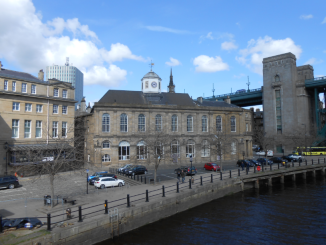
From here we crossed the Swing Bridge into the city. From the Swing Bridge you get a great view of the Guildhall, topped by the small white tower. It was the original Town Hall where the local government met. The original is from the 13th century, whilst the present building is from around 1658 when the previous building was enlarged by Robert Trollop, a local English Architect. It is used today as an overflow courthouse for the County Moot Hall (built in 1810) where most cases are tried.

From the Swing Bridge you also get a great view downstream, with the Sage Gateshead visible on the right hand side of the river. This is a major concert and theatre venue in Gateshead, which opened in 2004. The iconic reflective outer surface was glinting in the sun and it was an amazing sight.
Next to it, is the fourth of the 7 bridges, the Gateshead Millennium Bridge designed by Wilkinson Eyre and Gifford for the Millennium in 2000. It opened a year after the Millennium Celebrations, in 2001. It’s official opening came a year later in 2002. The whole thing was put into place as a signal unit, rather than being built over the river from scratch. One of the worlds largest floating cranes was used to hoist it into position, called the Asian Hercules II. The bridge also features on the British £1 from 2007.
The bridge has a rather interesting party piece. When a large boat or ship comes through, the whole thing tilts. On the pictures, the arch is holding the walkway up with cables. When it tilts the arch comes down and pulls up the walkway leaving a large gap for a boat to go through. It takes just 4 and a half minutes to complete the manoeuvre and completes it every now and then for events and sightseers.

From here we crossed back over to the Gateshead side to walk down to the 7th bridge to cross over again and get back round to the station. This is the 5th bridge down the river, and we walked underneath it on our journey.
This is the Queen Elizabeth Bridge which was built specifically for the Metro in 1976, to a design by W. A. Fairhurst & Partners from Glasgow. Construction took 2 years and it opened 3 years after completion, in 1981. Two companies helped build the structure, Cementation Construction Ltd and the Cleveland Bridge & Engineering Company from Darlington. Queen Elizabeth herself opened the bridge 11 days after the metro system opened.

As we crossed underneath the bridge, Gemma spotted a rather unusual art installation, a selection of Iron Goat sculptures on the embankment. These represent the fact that the name Gateshead may derive from “Goat’s Headland” as hundreds of years ago Goats roamed the area.

We kept walking, down to bridge number 6, the King Edward VII Bridge. This is the final railway bridge, which opened in 1906. Before this, all trains coming into Newcastle Station from the south used the High Level Bridge, but then to keep going out of the city back round South they would have to reverse back along the High Level. Now they could run round in a loop and back out over the new bridge.
Each bridge brings its own unique character to the city, and Newcastle wouldn’t be anywhere near as awesome if the 7 bridges didn’t own the skyline here. We had one more bridge to go, which we are going to walk across back into Newcastle, giving us the 7th and final bridge in our collection of bridges over the Tyne in Newcastle.

We climbed up the embankment and paused to look back at the bridge, the dull grey of the concrete contrasting well with the beautiful yellow of the newly flowered daffodils.
This one is called the Redheugh Bridge, a concrete traffic bridge. It is 897 metres long and opened in 1983, and is the third Redheugh bridge here. The first was designed by Thomas Bouch (1822 – 1880, whose Tay Rail Bridge at Dundee collapsed with a train running over it). Faults in the design soon emerged and it was demolished by the end of the decade. The second bridge opened in 1901, but again there were flaws and by the 1960’s it was demolished to build a new bridge.

The views from this bridge are fantastic, looking back across all the others to the Tyne Bridge. The spires of the city centre stand out well from here and a number of trains from Northern Rail, First Transpennine Express and East Coast all crossed at various times, so it’s a great spot for train spotters. I got this panoramic looking out from Newcastle, over the river into Gateshead. This is the furthest upstream you can cross the river to enter the city centre, and we finally could finally claim having been over all 7 bridges!

We crossed back into Newcastle City Centre, and went past the Centre for Life, a small science village with various attractions all about science, space and even a 4D Motion Ride. There are also other temporary exhibits that change all year round.
The centre opened in 2000, with Queen Elizabeth II present. It was designed by Sir Terry Farrell (Born in 1938, Arhictect from Manchester) and there is a variety of things for people of all ages to discover.
In the centre of the complex is the old Cattle Market Office, built in 1831, again by John Dobson. Originally it was the centre of a large cattle market, with the city walls also converging here, however it now stands alone, albeit in fantastic condition. It was also a toll house for crossings over the river.

As we moved back towards the City, we passed our last landmark, the Roman Catholic Cathedral of St Mary, built between 1842 and 1844. The designer was called Augustus Welby Pugin (1812 – 1852) and it is still in a fine condition today.
In 1850 a new diocese was required and St Mary’s was the perfect place to locate it, and it became the first Cathedral in the city (as St Nicholas’s didn’t get Cathedral status until 1882).
The spire is a fantastic height and stands out all over the city, and it is one of the tallest buildings in the city. Directly outside the building is a small monument garden dedicated to Basil Hume (1923 – 1999, local Monk) and a statue of him stands in the centre of the garden. A statue of Queen Victoria (1819 – 1901) stands outside St Nicholas’s Cathedral.

Transport wise, the whole county of Tyne & Wear is served by the Tyne and Wear Metro, a light rail system similar to the London Underground, although not as extensive. The network was opened in 1980 and makes use of existing lines around the county that were previously abandoned as well as new sections of track, as well as using the mainline through Sunderland at one point.
It is split into two lines, Yellow and Green.
Yellow:
The Yellow line begins at St James station in Newcastle City Centre. Most of the stations in the city centre are underground ones, including Monument shown above which is the 2nd stop on the line. The line then runs in a straight line to the coast at North Shields, round through Tynemouth and Whitley Bay, then back in land through the suburbs of Newcastle. It then comes back round through Monument (but not St James) then through Newcastle Central connecting to the mainline station, and then round through Gateshead to South Shields. The Shields Ferry also runs between North and South Shields and an all zone ticket on the metro includes using the ferry.
Green:
The Green line has its start at Newcastle Airport, before running round to Monument via the suburbs, through Newcastle Central then into Gateshead. It diverges from the same route as the Yellow Line at Pelaw stations and it heads out to Sunderland, over the river Wear and into Sunderland City Centre and round to South Hylton where it terminates.
Together the two lines serve 60 stations across all five districts in the county, with an overall length of 46.3 miles worth of track. The network uses overhead electric lines for power, and is one of only three light rail systems in the UK with the 3rd and smallest network being the Glasgow Subway.
The first time we visited Newcastle was last one November Evening, and we wandered down to the quayside and crossed the Millennium Bridge. The views at night are outstanding, with the sun setting behind the Tyne Bridge in a beautiful display. The Millennium Bridge also changes colour throughout the evening, from Red, to Green and then to Blue later on.
The East Coast Mainline from London to Edinburgh runs through the city, and is one of it’s major stops, with the line calling at Edinburgh, Berwick-upon-Tweed, York, Peterborough and London. Local travel connects the city to Durham, Middlesbrough and Carlisle. Newcastle International Airport just outside the city, and the A194 (M) leading from the A1 (M) terminates in Gateshead just outside the city. The only inner city piece of motorway is a very short piece of road making up the A167 (M) running from the Newcastle end of the Tyne Bridge through the city centre and out of the other side.
I hope you get a chance to visit Newcastle one day as there is a lot to discover, and crossing the bridges is a very rewarding experience.




